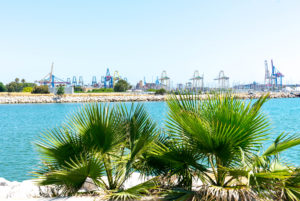
The eco-efficiency study has been carried out by researchers from the Centre for Research in Project Management, Innovation and Sustainability (PRINS) of the Universitat Politècnica de València.
The PAV also has Eco-efficiency Guides to promote sustainability criteria in companies in the port areas of Valencia, Sagunto and Gandia.
The Port Authority of Valencia (PAV) has led the eco-efficiency analysis in the ports of València, Sagunto and Gandia with a double objective: to know the level of eco-efficiency achieved by the cluster of companies and to define a strategy for continuous improvement. This initiative is part of the ECOPORT III project, in a scenario in which the maritime sector is carrying out actions to reduce environmental impacts and where the port authorities have a dynamic role to play in facilitating the companies belonging to their cluster to improve their environmental performance, collaborate and share know-how.
The eco-efficiency analysis has been carried out by researchers from the Centre for Research in Project Management, Innovation and Sustainability (PRINS) of the Universitat Politècnica de València for the years 2019 and 2020. For this study, statistical techniques have been applied that have made it possible to know which companies are part of the eco-efficiency frontier, those that are able to move more tonnes of goods while generating less environmental impact, and which have a relative margin for improvement with respect to the former. The measurement of this opportunity to make progress in each case has made it possible to establish a classification of eco-efficiency within the Valenciaport community.
Thirty-two companies participated in the study and were classified into two categories: port terminals and companies offering auxiliary port services. The results allow each company to know what level of eco-efficiency it achieves or to set impact reduction targets to improve its work. Finally, within each category, terminals and companies that share similar casuistry have been grouped together, allowing the PAV to have a global vision of the weaknesses and strengths of each group and facilitating the search for common solutions for companies with similar environmental performance.
The study has been positively received by the participating companies, which have classified it as relevant and very useful, as it has allowed them to know the starting point they are at and the environmental objectives they should achieve to improve their current results, information that is necessary to undertake any business improvement initiative. The data obtained in this analysis, which has provided information on the eco-efficiency situation of the different companies, the nature of their operations and their objectives for improvement, will enable the PAV to continue working in the coming years to design a differentiated plan to increase the eco-efficiency with which it currently operates in the port community.
In addition, Valenciaport has Eco-efficiency Guides which aim to promote sustainability criteria in the companies of the port areas managed by the PAV. The guides include various proposals and actions that enable the production of goods and services while consuming fewer natural resources and, as a consequence, reduce pollution through ecologically and economically efficient procedures.

